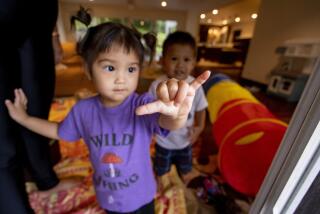Change is good on Lanai
Iwas about to visit Lanai’s two luxury resorts for the first time since Four Seasons came aboard and gave each a $50-million renovation, and I hoped they hadn’t changed.
They hadn’t. Much.
Oh, they have fancier names. The Manele Bay Hotel is now the Four Seasons Resort Lanai at Manele Bay. Its sister hotel, the Lodge at Koele, is now the Four Seasons Resort Lanai, the Lodge at Koele. What’s in a name? The Four Seasons imprint is evident at both properties, but is, for the most part, subtle.
“We’ve kept the heart and soul” of the lodge, said the resorts’ general manager, Mark Hellrung. “People said, ‘Oh, please don’t turn it into Four Seasons Maui.’ ”
They haven’t.
The changes in the island’s two major resorts reflect those on Lanai as a whole. The smallest of Hawaii’s major islands, Lanai was once the home of a thriving pineapple plantation. But as pineapple became economically unattractive as a crop, the island reinvented itself as a resort destination. That, however, has not allowed development to change the pace and simplicity of life here. Similarly, the resorts’ renovations have not detracted from their -- or the island’s -- natural beauty and ambience.
Hellrung and I were having tea beside a massive stone fireplace in the Lodge at Koele’s spectacular Great Hall. The hotel, which opened in 1991, and the Manele Bay resort (1990) were developed and are owned by Castle & Cooke. They had become a tad tired during three earlier managements, Hellrung said. “The 15-year mark is when you have to do something major,” he said, especially when properties are open to the elements.
The lodge was closed for three months and stripped and painted. Lobby furniture was updated; flat-screen TVs were added to guest rooms; new chefs and menus brought new flavors and tastes.
The sister resorts are as different as can be. The Koele property feels like an upscale hunting lodge in the tropics while the Manele Bay property is designed as a beach resort, with an eclectic look that combines Hawaiian-Polynesian-Mediterranean styles with an Asian influence. Both showcase exquisite Asian art and antiques.
This dichotomy, Hellrung said, is one thing that attracted Four Seasons -- two resorts with decidedly disparate personalities on a small, private Hawaiian island.
The lodge has a small pool and fitness center, the Greg Norman- designed Experience at Koele golf course and manicured gardens surrounding a reflecting pond. From the casual Terrace, diners overlook gardens and gazebo. The pièce de résistance is the lodge’s octagonal dining room with its peach walls, floral fabrics and dark woods. I enjoyed a superb rack of lamb and then settled into a roomy chair in the Great Hall for live music.
But with no beach, what’s there to do? Try croquet, tennis, shooting sports, horseback riding, biking and hiking in the pine-dotted hills. And, it’s 20 minutes by shuttle to the other hotel, which overlooks a white sand beach at beautiful Hulopoe Bay. Guests at either resort may use the facilities of both.
“We spent a lot of time answering the question, ‘What is there to do on Lanai?’ ” Hellrung acknowledged, “so we’re beefing up the activities.” The lodge has a new game room with billiards, foosball and such. Management hopes to engage more local talent as entertainers.
AWAY FROM THE CRUSH
Four Seasons has initiated helicopter tours over Molokai and the West Maui Mountains and brought in a surf school. “Generally, you’re the only person on the beach with the instructor,” said Waynette Ho-Kwon, director of the Lanai Visitors Bureau. “It’s not like Waikiki, with 9,000 people crashing into each other.”
For those who need more action, the passenger ferry to bustling Lahaina, Maui, makes the 45-minute trip across the Auau Channel five times daily. Lanai, by contrast, is blissfully laid-back. “We’ve had people get off the boat from Maui and take the next one back,” said Ho-Kwon. “They’d say, ‘Is that all there is?’ ”
Lanai has only 30 miles of paved roads and a limited number of attractions. The best idea is to rent a Jeep for a day to drive to the Garden of the Gods (a canyon with eerie rock formations) and Shipwreck Beach.
Visitors may buy a shuttle pass on arrival ($33 for adults, $16 for children) that covers round-trip transportation from the airport to lodgings and to the harbor for the ferry to Maui. Shuttles run every half-hour between the lodge and the resort at Manele Bay, with a stop in between at Hotel Lanai.
Changes at the 236-room Manele Bay resort, which reopened as a Four Seasons in October 2005, include an ocean-view lobby-level fitness center to complement the full-service spa. The poolside Ocean Grill has been expanded and an open-air bar added.
For very high rollers, there’s the elegant new Alii Suite, which can be configured with three bedrooms -- and more than 4,000 square feet -- at $8,940 nightly. From its lanai, I watched spinner dolphins put on a show.
This is a low-rise hotel, with little gardens, ponds, streams and waterfalls. My large corner room had green and gold décor with tropical prints and a wraparound ocean-view lanai. The marble bath was luxurious.
One evening, after a salad at the pool bar, I found a chaise longue poolside and just star-gazed. Another night, I enjoyed pupus in the lobby-level Hale Ahe Ahe Lounge, where there was live entertainment.
Lanai has a third hotel, the 11-room Hotel Lanai, which is in a one-story frame building in town. It dates from 1923 and once was a retreat for executives and guests of James Dole’s Hawaiian Pineapple Co.
It too is changing. Last year, it was leased by Tom Kiely and Mary Charles -- who have homes on Oahu and Lanai -- and their nephew, Mike Charles. All three partners have hospitality industry experience.
I can’t explain my fondness for this hotel. Fancy it isn’t. Some rooms are nicer, including Nos. 6 and 8, and the four front ones share verandas, but baths are small. Rooms have phones and fans, but no TVs. Starting at $139 per night, they’re a bargain by Hawaiian standards.
At one time, the hotel was so casual that a guest could throw on a robe and pad out to the kitchen for morning coffee. Now, a nice continental breakfast is available. There’s complimentary coffee, set out on a pretty veranda with wicker chairs.
“It might have been insanity” to buy the place, Kiely said, “but the hotel plays a very important role on the island. We felt if somebody bought it who didn’t have an understanding of the community, if it changed too much, it might not be a good thing.”
I wondered how the arrival of Four Seasons, a company with guests so devoted to the brand that some visit hotels rather than destinations, might affect Lanai (population 3,466).
“There are definitely people who come in and say they only stay at Four Seasons,” said Kathy Carroll. She and her husband, Mike, run the upscale Mike Carroll Gallery in Lanai City’s downtown, the little area surrounding Dole Park. “It does seem like those coming now really appreciate art.”
The Carrolls came from Chicago six years ago, figuring they could move back if things didn’t work out. On Lanai, Mike said, “You’re surrounded by 1930s Hawaii. That’s a romantic thing to paint.” Lanai is a friendly place, said Kathy. Small changes make news here, such as the opening last year of the Sweetest Days, an ice cream shop. The town also has a couple of gift shops, a clothing boutique, a movie house, four small restaurants, a coffee place (local) and three markets.
HEALTHY TOURIST INDUSTRY
Although only 1.1% of visitors to Hawaii in 2006 came here (about 85,000 people), tourism is Lanai’s economic driver. “We’ve got more jobs than we have manpower,” virtually all in tourism (850), said Ho-Kwon. Resort jobs have lured back some of those who left because they didn’t want to work in the pineapple fields. There once was a saying, “Lanai has two exports, pineapple and kids.”
Although most locals live modestly, Kathy Carroll says, there’s little resentment of vacationing haoles. “That whole divide, you and us, we don’t have that, thank God. They come, they visit and they enjoy the Lanai we have. We’re not going to knock all this down and build a Starbucks.”
Mainlanders who move here are welcome, she said, “so long as they live like the islanders [albeit in luxury homes] and make an effort to learn about the island.” It’s definitely not Maui -- that’s where locals go to shop at Wal-Mart and Costco, then hurry home.
In truth, Lanai has always had both wealthy and working classes. Ho-Kwon drove me to a highlands area called Snob Hill or Haole Camp, where Dole VIPs once lived in sprawling homes.
Castle & Cooke, a private company owned by Angeleno David Murdock, owns 98% of the island and has been developing luxury homes here. Mary Hakoda, principal broker for Island of Lanai Properties, said its 20-year plan focuses on balancing growth with preserving lifestyle.
“It’s a struggle,” said Donna Tomita, a vice president of Castle & Cooke Homes Hawaii. “I think the day Lanai has a traffic light will be traumatic for most people.”
Murdock appears to have done many things right. “He saved the island more than once,” said Ho-Kwon. “First, he understood that pineapple was finished. Then, he made sure something replaced it. We were the forethought, not the afterthought.”
Most of the 160 properties developed to date have sold. Of these, 90% have been to mainlanders, half of whom are Californians. Prices range from $935,000 for a detached condo at the Pines at Koele to $6.2 million for a 2-acre oceanfront homesite.
Luxury second homes on Lanai have changed things “in certain subtle ways,” said Riki Hokama, who grew up here and now chairs the Maui County Council, which includes Lanai. “In the past, nobody would ask for pâté and Champagne” at the local markets, where staples include fishing gear and saimin noodles.
Hokama stops short of saying there’s no “us versus them” sentiment. It exists, he said, “but not to the extent it exists on Molokai,” where locals openly resent wealthy newcomers. “Our community has been very reasonable in what it’s been willing to give up in return for certain advantages. We want the north shore left alone for hunting and fishing,” and Castle & Cooke has done that.
Lanai will welcome mainland millionaires, Hokama said, “as long as the millionaires keep in mind why they came here and are not coming in hoping to change who we are.”
More to Read
Sign up for The Wild
We’ll help you find the best places to hike, bike and run, as well as the perfect silent spots for meditation and yoga.
You may occasionally receive promotional content from the Los Angeles Times.






